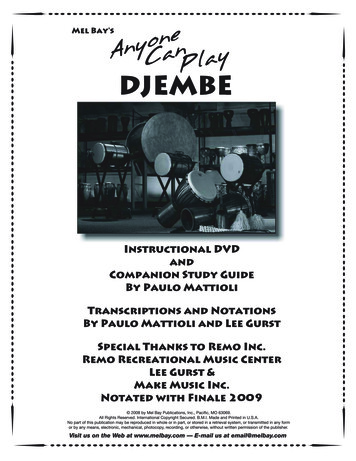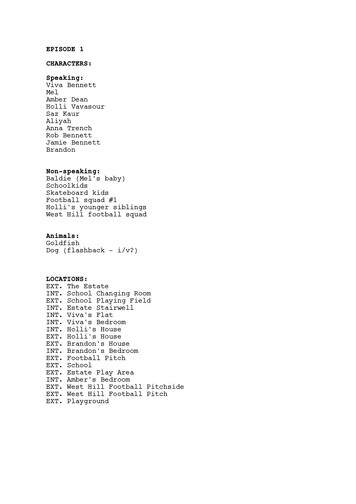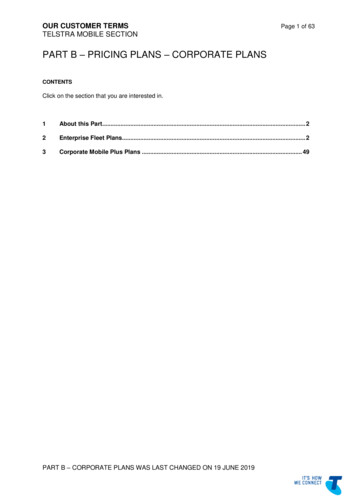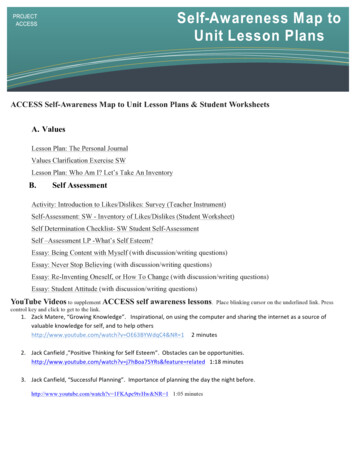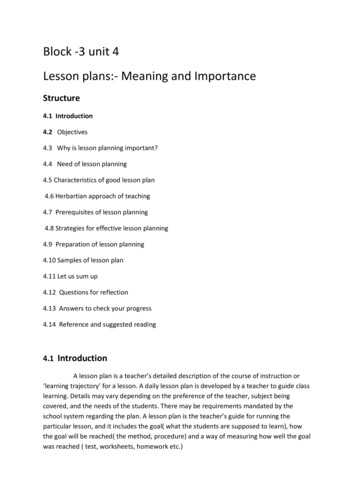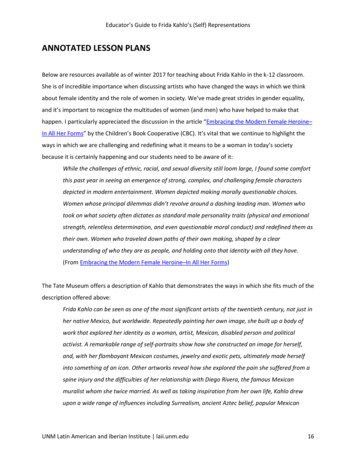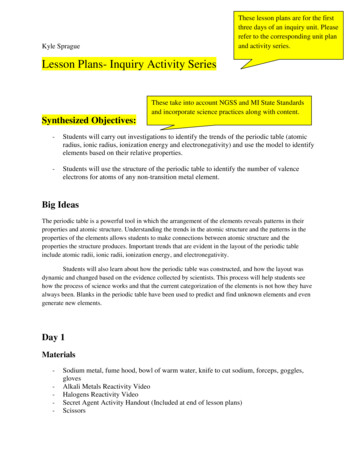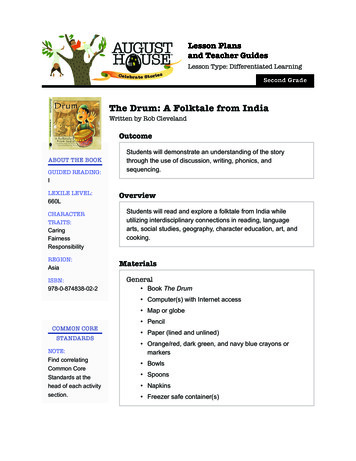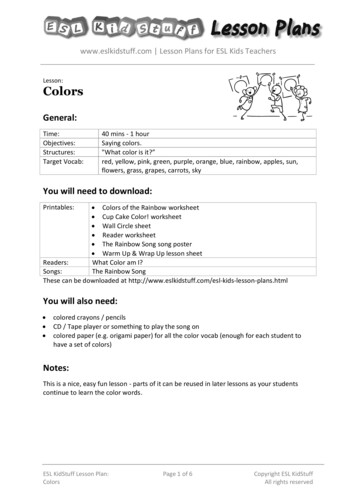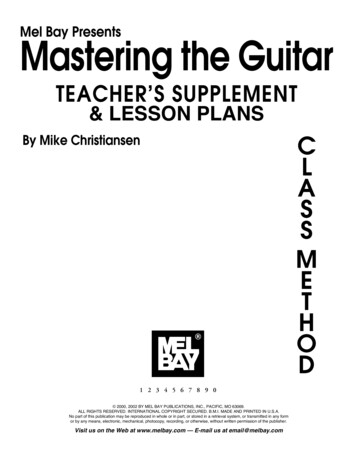
Transcription
& LESSON PLANS 1 2 3 4 5 6 7 8 9 0 2000, 2002 BY MEL BAY PUBLICATIONS, INC., PACIFIC, MO 63069.ALL RIGHTS RESERVED. INTERNATIONAL COPYRIGHT SECURED. B.M.I. MADE AND PRINTED IN U.S.A.No part of this publication may be reproduced in whole or in part, or stored in a retrieval system, or transmitted in any formor by any means, electronic, mechanical, photocopy, recording, or otherwise, without written permission of the publisher.1 — E-mail us at email@melbay.comVisit us on the Web at www.melbay.com
Table of ContentsForeword . 3Making The Guitar Class Work . 4What Instruments To Use . 4Room Set-Up . 5Tools To Have On Hand. 5Tuning . 5Holding Position . 7Warm-Up. 7Layered Learning . 8Chords or Melody First . 8Quizzes. 9Rounds . 9First Ensemble Piece . 9Rhythms . 9Note Reading vs. Tablature . 10Strumming Techniques . 10Ensembles . 10Application of Cross-Curriculum Material . 15Teaching Improvisation . 17Listening . 18The Guitar Recital . 18Selecting a Private Instructor . 21Stringing the Guitar. 23Music Educator’s National ConferenceMusic Contents Standards Grades K-12 . 32Lesson Plans . 34Additional Lessons . 58Artists . 59Manuscript Paper . 60Tablature Paper . 61Blank Chord Diagrams . 62Seating Chart. 63Notes . 642
ForewordThe information contained in this supplement will be a valuable tool in showing teachers how toapply the material contained in the Mastering the Guitar Class Method. This manual is designed to be usedin conjunction with the Mastering the Guitar Class Method. Rather than put excerpts from the student bookin this supplement, references will be given to pages in the method book containing the examples beingdiscussed. This will allow the entire example to be seen as it is presented in context. This supplement will notonly help the teacher effectively present the material in the class method, but it will also provide a springboard for creating original ways to teach music and cross-curriculum concepts.A portion of this supplement is devoted to lesson plans. Ninety-six, fifty-minute lesson plans arepresented. In addition, suggestions are given for creating extra lesson plans. Although these lesson plans willwork well as they are written, they are not in stone, and the teacher may wish to modify them or createoriginal lesson plans by using various combinations of the “Content Categories” found on page 34.Listening plays an important role in the guitar class. To assist the teacher is selecting high qualityguitar music, page 59 of this Teacher’s Supplement contains a list of guitar recording artists and the style ofmusic played by each. From this list, the teacher may select any recordings by these artists for the students’listening.Although the Class Method contains plenty of exercises, solos, and ensemble pieces, and supplementing the method book with other music is not required, some teachers may find that it will workwell to supplement the method with other ensemble pieces and popular music. Because of the “heretoday, gone today” nature of popular music, specific popular tunes are not included. However, many contemporary styles are represented in the music contained in the method. The music in the Mastering the GuitarClass Method was written to be timeless. The techniques are presented in such a way that it will be easyfor the students to see how to apply them to popular music. For example, when students learn strumpatterns for 4/4 and 3/4, they can be shown how to apply those strum patterns to other music as well as themusic contained in the method.On the split-channel CD which goes with the Mastering the Guitar Class Method, the student partshave been recorded on one channel, and the accompaniments have been recorded on the other channel. Thishas been done so the students, by panning the recording, can play with the solo part, with only the accompaniment, or with both. On the vocal pieces, the melody is played instrumentally on one channel and theaccompaniment is played on the other channel. This way the student can sing the piece while hearing only themelody, with the accompaniment, or with both.Although the method book will work well with private students, this method was written to be used asa class method. The amount and quality of the music, the inclusion of ensemble music, the quizzes, the crosscurriculum materials, and the Teacher’s Supplement will provide the instructor with ample material necessary for a successful guitar class.3
Making the Guitar Class WorkThere are many ingredients which go into making a successful guitar class. Four of the ingredientswhich are crucial are: 1) an enthusiastic, optimistic teacher, 2) the use of a quality text, 3) using repertoirewhich is educational, fun, and inspiring, 4) having a performance as the goal.The teacher of the guitar class does not have to be a world class performer. Some of the finest guitarplayers may not be the best teachers. However, many fine players are also outstanding teachers. The important factor is that the teacher’s level of proficiency be more advanced than the students. Besides, you have theteacher’s manual right? The guitar skills of many fine classroom teachers are slightly more developed thanthe skills of the students and often teachers find themselves developing and refining their skills along withthe students.Using a quality text can make the classroom experience more rewarding for the teacher and students.The Mastering the Guitar Class Method has many features which make it unique and “user friendly.” Thismethod was designed so the teacher should not have to supplement the classwork with additional material.The Mastering the Guitar Class Method contains accompaniment styles, solos, and ensembles. The techniques (accompaniment styles, note reading, etc.) presented in the class method can also be applied to musicfrom song books and sheet music.The music selections chosen and written for the class method are interesting, fun, and should inspirethe students to practice. Because the repertoire is graded and has been and sequenced, it will motivate andnot overwhelm students.Regardless of the size of the class, a performance should be the goal. Nothing will motivate studentsmore than the goal of having a performance. Concerning repertoire, there is enough material in this classmethod for several recitals. Later in this supplement, some suggestions will be given for programming astudent recital.What Instruments To UseThe Mastering the Guitar Class Method is written is such a way that any type of guitar can be used. Inthe typical beginning class, there will be steel string, nylon string, electric, and maybe even a twelve stringguitar. It would be wonderful if the guitars were all uniform, but this is highly unlikely. Because the studentswill be sitting in the standard folk sitting position, any guitar will do. Most guitars will play in the first fourfrets and the material in this book will not extend beyond those frets. While it is not critical the students allhave the same type of guitar, it is important the students know the type of guitar they are playing. Have thestudents look at page two and find the type of guitar they are playing. If a student has an electric guitar, youmay want to encourage him/her to buy, or borrow, an acoustic guitar. Another possibility would be to havethe electric guitar player(s) use small practice amps in the class. Be very cautious doing this because even atlow volume levels, the electric guitar may sound louder than all of the acoustic guitars combined.4
If you have the good fortune of selecting or buying guitars for the class, it is recommended the students use standard size nylon string guitars. The nylon strings will be easier on the fingers. If they wish, theycan convert easily to steel-string and/or electric guitars later. Occasionally, a student has a guitar which is“terminal” and will not play at all. This could be the result of a broken nut, a broken bridge, or the action(distance between the string and the fret) is too high or too low. If this happens, take the guitar to a qualifiedrepairman. Be careful not to degrade the students, or their relatives, by being too critical of their instruments.Room Set-UpThe guitar class will run much smoother if the environment is comfortable. The lighting should begood and the temperature comfortable. It works well to have two students to one music stand, so the guitarscan be seen and heard. If there is room at the back or side of the class, have the students put their cases there.There should be a blackboard or a whiteboard. The teacher should sit on a stool if possible. The elevation isimportant in seeing the students and letting them see the teacher. The teacher should wear a guitar strapwhile teaching the class. This will make it possible to move about the classroom and observe and helpstudents.Tools To Have On HandA few essential tools are necessary in the classroom. Keep an extra set of strings handy in case astudent or the teacher breaks a string. An electronic tuner, pitch pipe, or tuning fork will be needed. Althoughthe guitar will go out of tune between classes, if the class is tuned to the same pitch each session, it will beeasier to tune the guitars in future classes. Have extra picks, manuscript paper, and pencils. It would also begood to have a string winder in case a string has to be changed quickly or a gear is difficult to turn. Stringwinders are available at any music dealership.TuningAlthough the students must eventually learn to tune their own guitars, the teacher should tune themfor the first several sessions. Tuning is difficult and will take practice. A method of tuning a guitar classwhich is quick is sometimes referred to as the “beacon” method. This is done by tuning one class member’sguitar to pitch, and then by having that same student play the first string (or others if needed) as the teachertunes the other guitars. The teacher can tune the guitars by matching the fifth fret (the fourth fret on the thirdstring) with open strings. The method is presented in the book on page 7.A quicker method of tuning would be to match the first string open with the “beacon” guitar and thenmatch the second string, fifth fret to the first string open. Then, match the third string open (G) to the octavehigher G (first string, third fret). The notes are an octave apart, but easy to tune. After the third string is tuned,5
match the fourth string open to the second string, third fret. Match the fifth string open to the third string,second fret. Finally, match the sixth string open to the fourth string, second fret. Most of the music thestudents will be learning first is in the key of G, so they will be playing a lot of open strings. As the teacher istuning the guitars, the students can be warming up softly. This will not interrupt the tuning process. Tuningthe class will become faster and easier with practice. It is important to expedite the tuning. The students (andthe teacher) will become impatient if the time to tune drags on.Another fun method of tuning, which is unique to the Mastering the Guitar Class Method and helpstrain the ears of the students, is to use the tuning portion of the CD which accompanies the class methodbook. This method of tuning is unique because rather than having only the single open strings played on therecording for pitch matching, there is also an accompaniment recorded for tuning.In the tuning portion of the CD, one channel of the stereo recording has the open strings of the guitarbeginning with the first (smallest) string, E, then B, G, D, A, and E. Each note is played eight times. On theother channel of the stereo recording is a rhythm track with rhythm guitar, bass, and drums. The accompaniment plays the following chords: Em, B7, G, D, Am, and Em. Each chord is played eight times,
can convert easily to steel-string and/or electric guitars later. Occasionally, a student has a guitar which is “terminal” and will not play at all. This could be the result of a broken nut, a broken bridge, or the action (distance between the string and the fret) is too high or too low. If this happens, take the guitar to a qualified repairman. Be careful not to degrade the students, or their relatives, by being too critical of
